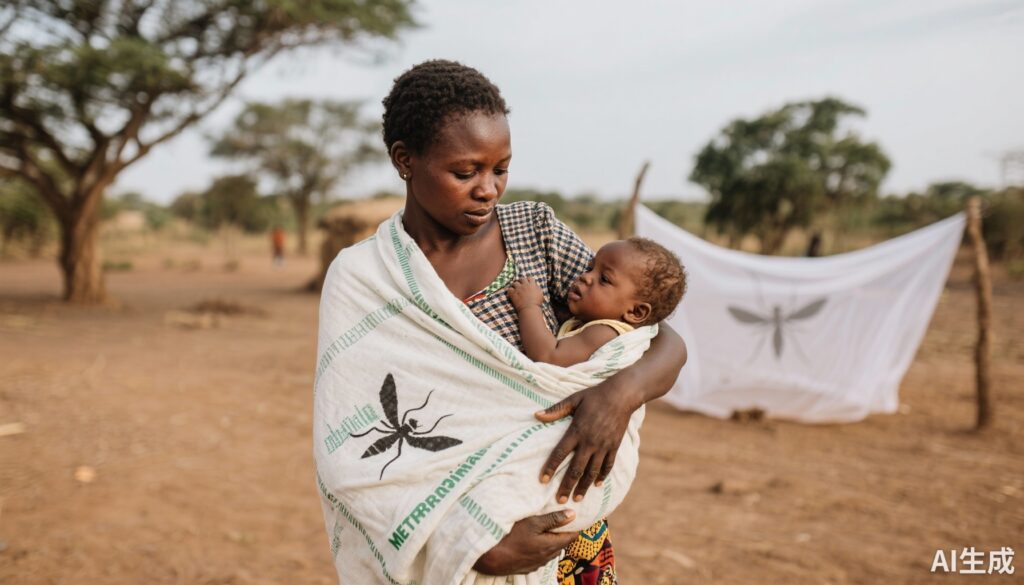Highlight
– Permethrin-treated baby wraps substantially reduce clinical malaria incidence in infants aged 6–18 months.
– The intervention was evaluated in a rigorous double-blind, randomized, placebo-controlled trial in Uganda.
– Protective effect observed despite universal provision of long-lasting insecticide-treated bed nets.
– Rash occurrence was slightly higher but generally mild and manageable in the intervention group.
Study Background and Disease Burden
Malaria remains one of the most significant causes of morbidity and mortality among children in sub-Saharan Africa, contributing substantially to under-five mortality rates in endemic regions. Despite widespread distribution of long-lasting insecticide-treated nets (LLINs), malaria cases persist due to factors including residual mosquito activity and inconsistent LLIN use. Infants and young children (6–18 months) bear a disproportionate share of this burden, underscoring the need for complementary and culturally adapted preventive measures. Leveraging traditional childcare practices, specifically the common use of cloth wraps by mothers to carry infants on their backs, this study assessed whether impregnating such wraps with permethrin—a synthetic pyrethroid insecticide with established efficacy—could offer an additional protective barrier against malaria transmission.
Study Design
This investigation was conducted as a double-blind, randomized, placebo-controlled trial in Uganda from June 2022 to April 2024. The target population included adult women who cared for a child aged 6 to 18 months, reflecting a critical window for malaria vulnerability. Mother-child pairs were randomly allocated in a 1:1 ratio to receive either permethrin-treated baby wraps or sham-treated (placebo) wraps. The treatment/control wraps underwent re-impregnation every four weeks to maintain insecticidal activity over the 24-week study period. To ensure baseline protection adherence, all mother-child pairs received new pyrethroid-only LLINs, representing the current standard of care.
Clinical visits were scheduled biweekly, with provisions for unscheduled visits should the child develop febrile illness. The primary efficacy endpoint was the incidence of clinical malaria in children, defined by the presence of fever plus a positive result on a malaria rapid diagnostic test (RDT).
Key Findings
Of 419 mother-child pairs screened, 400 were randomized equally between intervention and control arms, with excellent retention and adherence—clinic attendance reached 99.9%, and no participants were lost to follow-up.
The intervention yielded a profound reduction in malaria incidence. Children using permethrin-treated wraps experienced an incidence rate of 0.73 clinical malaria cases per 100 person-weeks (95% confidence interval [CI], 0.51 to 1.02), compared to 2.14 cases per 100 person-weeks (95% CI, 1.73 to 2.62) in the control group. This corresponds to an incidence rate ratio (IRR) of 0.34 (95% CI, 0.23 to 0.51; P<0.001), indicating a 66% relative reduction in clinical malaria risk attributable to the intervention.
Adverse effects were limited and manageable. Rash was more frequently reported in the intervention group (8.5%) than in controls (6.0%), predominantly mild in severity and consistent with known permethrin exposure effects, without leading to study discontinuation.
The trial's rigorous methodology—including blinding, placebo control, high follow-up rates, and uniform LLIN use—strengthens the validity of these findings. This layered protective approach highlights the additive benefit of permethrin-treated wraps beyond standard bed net use.
Expert Commentary
This landmark study introduces an innovative vector control strategy embedded within culturally appropriate child-rearing practices. By utilizing permethrin-treated cloth wraps, the intervention targets the critical exposure window when children are often held close to their mothers and may be vulnerable to mosquito bites, complementing bed net protection that primarily guards during nighttime sleep.
Biologically, permethrin has a well-established safety and efficacy profile in vector control. Its application to baby wraps is rational, given the close and prolonged proximity to mosquito vectors during daytime hours. The 66% reduction in malaria incidence observed is clinically significant and comparable to other standard malaria prevention modalities.
While rashes were noted, their low frequency and mild nature suggest the intervention is generally well-tolerated. Nonetheless, monitoring for potential dermal reactions remains prudent in future implementation.
Limitations include the study’s geographic restriction to Uganda and a relatively short follow-up of 24 weeks; therefore, broader regional efficacy and longer-term safety require confirmation. Additionally, the study population had access to LLINs, and the intervention’s standalone efficacy without bed nets remains untested.
This intervention’s integration into existing malaria control programs could potentially enhance protective coverage, especially in settings where LLIN use compliance wanes or where early evening and daytime mosquito biting undermine net effectiveness.
Conclusion
The trial provides robust evidence that permethrin-treated baby wraps can significantly reduce clinical malaria incidence in infants when used in conjunction with bed nets. This culturally sensitive and easily implementable intervention may serve as an important adjunct to existing control strategies in malaria-endemic regions, particularly in sub-Saharan Africa.
Future research should explore scalability, cost-effectiveness, longer-term safety, and impact across diverse epidemiologic settings. As the fight against malaria demands innovative multipronged approaches, leveraging indigenous caregiving customs combined with proven insecticidal technology emerges as a promising path forward.
References
Boyce RM, Shook-Sa BE, Ndizeye R, Baguma E, Giandomenico D, Cassidy CA, Eshun S, Siedner MJ, Staedke SG, Ntaro M, Juliano JJ, Reyes R, Mulogo EM. Permethrin-Treated Baby Wraps for the Prevention of Malaria. N Engl J Med. 2025 Sep 24:10.1056/NEJMoa2501628. doi: 10.1056/NEJMoa2501628. Epub ahead of print. PMID: 40991921; PMCID: PMC12462887.
World Health Organization. World Malaria Report 2023. Geneva: WHO; 2023. Available from: https://www.who.int/publications/i/item/9789240064898
Lengeler C. Insecticide-treated bed nets and curtains for preventing malaria. Cochrane Database Syst Rev. 2004;(2):CD000363. doi:10.1002/14651858.CD000363.pub2.
Additional Notes
With rising insecticide resistance and persistent malaria transmission despite LLIN use, novel interventions such as permethrin-treated wraps can play a critical role in closing gaps in malaria prevention. The alignment with local cultural practices enhances acceptability and potential sustainability.



